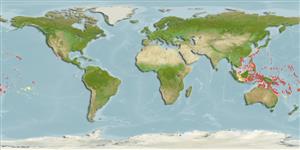>
Eupercaria/misc (Various families in series Eupercaria) >
Labridae (Wrasses) > Cheilininae
Etymology: Oxycheilinus: Greek, oxys = sharp + Greek, cheilos = lip; nigromarginatus: Name from the Latin, meaning black-margined, referring to the conspicuous black posterior margin on the caudal fin, the only obvious color marking persisting in preservative..
More on authors: Randall, Westneat & Gomon.
Environment: milieu / climate zone / depth range / distribution range
Ecologia
marino associati a barriera corallina; distribuzione batimetrica 10 - 27 m (Ref. 56651). Subtropical
Southwest Pacific: from New South Wales, Chesterfield Bank in the Coral Sea, New Caledonia and Tonga.
Size / Peso / Age
Maturity: Lm ? range ? - ? cm
Max length : 11.3 cm SL maschio/sesso non determinato; (Ref. 56651); 8.2 cm SL (female)
Short description
Morfologia | Morfometria
Spine dorsali (totale): 9; Raggi dorsali molli (totale): 10; Spine anali 3; Raggi anali molli: 8; Vertebre: 23. This species is distinguished by the following characters: Dorsal rays IX, 10; anal rays III, 8; pectoral rays 13; lateral-line interrupted, with pored scales to caudal-fin base 15 + 6; gill rakers 5-6 + 8-9; body moderately elongate, depth 3.1-3.55 in SL; head length 2.45-2.55 in SL; snout long and pointed, 2.6-2.8 in head; dorsal profile of snout straight or with a slight concavity of snout to above eye; lower jaw is slightly projecting; maxilla reaching or nearly reaching a vertical at anterior margin of orbit; caudal fin of females slightly rounded, the upper 3 principal rays slightly prolonged; fin of males rhomboid with the upper 3 rays more strongly projecting; pectoral fins 2.6-2.95 in head; body and fins pale yellowish when preserved, with a blackish posterior margin on caudal fin, broader and black in male; first interspinous membrane of dorsal fin dusky; red in life on about upper half of body with 5 irregular pale bars, pale red on lower half with 3 pale stripes containing small white spots; posterior edge of caudal fin blackish to black (Ref. 56651).
Collected in protected waters of lagoons or harbors on mixed sand and coral-reef habitats (Ref. 56651).
Life cycle and mating behavior
Maturità | Riproduzione | Deposizione | Uova | Fecundity | Larve
Oviparous, distinct pairing during breeding (Ref. 205).
Randall, J.E., M.W. Westneat and M.F. Gomon, 2003. Two new labrid fishes of the genus Oxycheilinus from the South Pacific. Proc. Calif. Acad. Sci. 54(20):361-370. (Ref. 56651)
IUCN Red List Status (Ref. 130435)
Threat to humans
Harmless
Human uses
Informazioni ulteriori
Age/SizeAccrescimentoLength-weightLength-lengthLength-frequenciesMorfometriaMorfologiaLarveDinamica popolazioni larvaliReclutamentoAbbondanzaBRUVS
BibliografiaAcquacolturaProfilo di acquacolturaVarietàGeneticaElectrophoresesEreditarietàMalattieElaborazioneNutrientsMass conversion
CollaboratoriImmaginiStamps, Coins Misc.SuoniCiguateraVelocitàModalità di nuotoArea branchialeOtolithsCervelliVista
Strumenti
Special reports
Download XML
Fonti Internet
Estimates based on models
Preferred temperature (Ref.
123201): 25 - 28.2, mean 26.5 °C (based on 239 cells).
Phylogenetic diversity index (Ref.
82804): PD
50 = 0.5020 [Uniqueness, from 0.5 = low to 2.0 = high].
Bayesian length-weight: a=0.01585 (0.00707 - 0.03555), b=2.95 (2.76 - 3.14), in cm total length, based on LWR estimates for this (Sub)family-body shape (Ref.
93245).
Trophic level (Ref.
69278): 3.7 ±0.6 se; based on size and trophs of closest relatives
Resilienza (Ref.
120179): Alto, tempo minimo di raddoppiamento della popolazione meno di 15 mesi (Preliminary K or Fecundity.).
Fishing Vulnerability (Ref.
59153): Low vulnerability (10 of 100).
